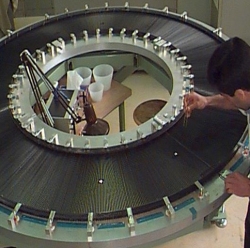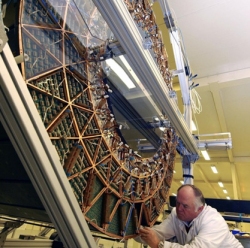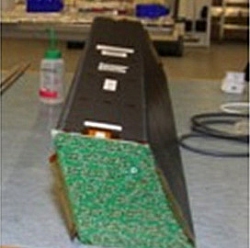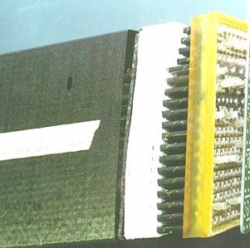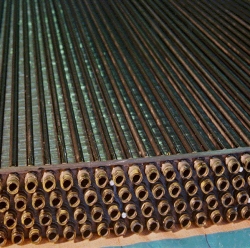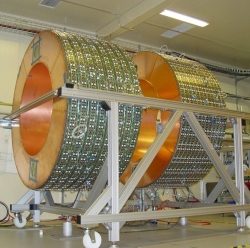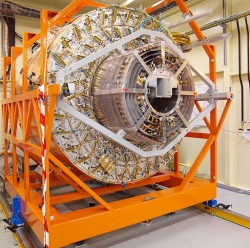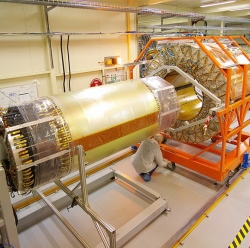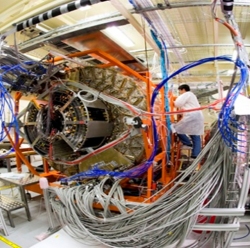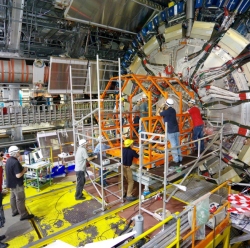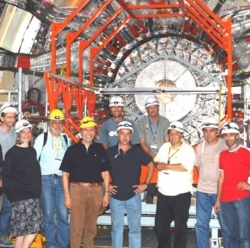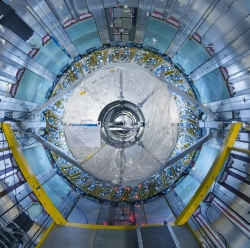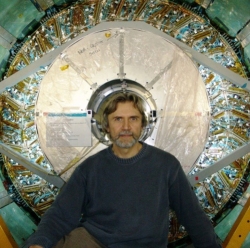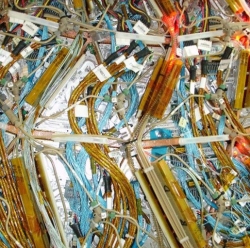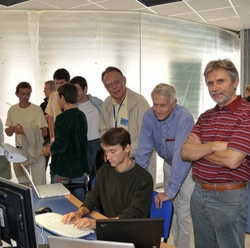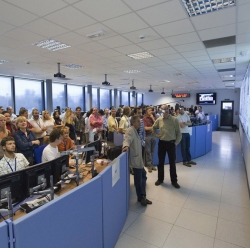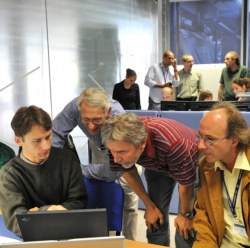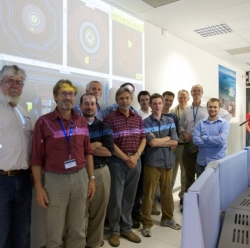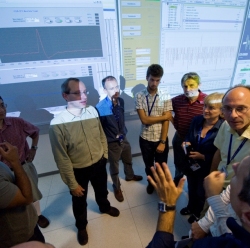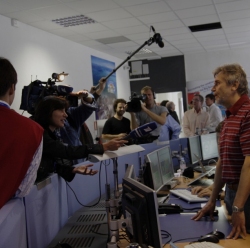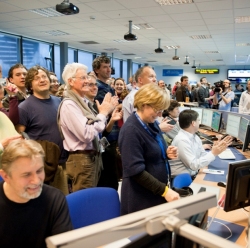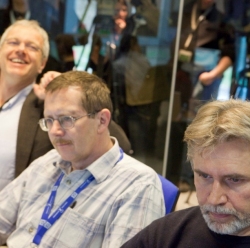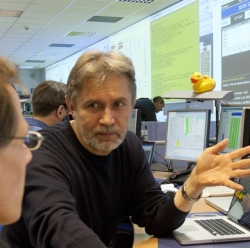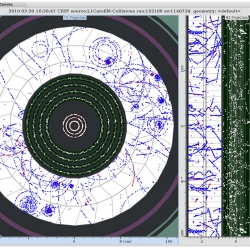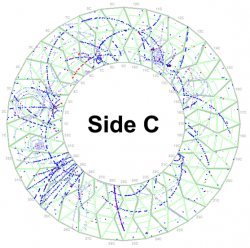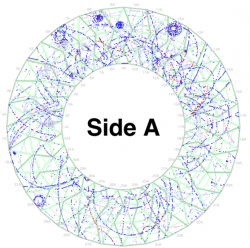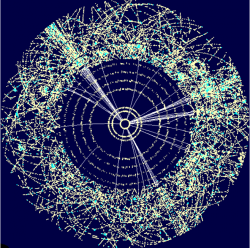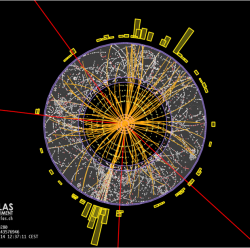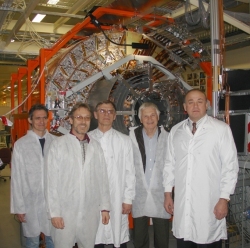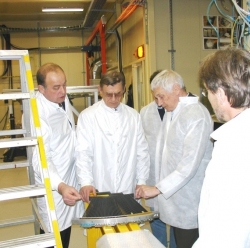ATLAS TRT (Transition Radiation Tracker)
ATLAS TRT collaboration includes 18 universities and laboratories.
Collaboration members: Switzerland, France, Denmark, Germany, Canada, Poland, Russia, USA, Turkey, Sweden.
ATLAS TRT project leader: prof. A. Romaniouk.
ATLAS TRT is a transition radiation tracker. Being a part of ATLAS Inner Detector, it is designed to register particles tracks, measure their momenta and identify them based on transition radiation effect. Transition radiation is emitted when a relativistic particle passes through a boundary between two media with different permittivity values. TRT is a creation of colleagues from our institute and has no equals. A lot of ideas are used in some other high-energy physics and astrophysics international experiments such as transition radiation detector for HERA-B (DESY), transition radiation detector for TRT AMS (International Space Station), forward tracker for ZEUS (DESY) and some others with our colleagues taking active part in them.
Transition radiation was discovered in 1950s by Soviet scientists (later academicians) V. Ginzburg (2003 Nobel laureate) and I. Frank, and its theory as applied to particles detectors was developed by a member of Yerevan Physics Institute G. Garibyan. Relation between intensity of transition radiation and particles Lorentz factor is of threshold nature for X-ray radiation. It allows to identify particles masses (usually to separate electrons from other particles).
First works on transition radiation detectors development have started in MEPhI under prof. B. Dolgoshein’s guidance in the early 1970s. These activities laid the groundwork for TRDs application in high-energy physics and astrophysics.
MEPhI group proposed a novel concept of transition radiation tracker for experiments at future SSC and LHC colliders in 1989. RD6 international collaboration was founded in 1990 based on these ideas. It was led by B. Dolgoshein till 1994. TRT project won a tough competitive battle against other proposals and was annexed to the ATLAS experiment.
TRT is a unique device since it operates under unprecedented conditions compared to other gas detectors. 10 billion particles are produced every second at LHC. This is several hundreds more than in any previous experiments. All these particles should be registered and identified. Their tracks have to be reconstructed with 10-100 microns precision depending on distance to the interaction point. These conditions put severe constraints on detector operation speed, positional resolution and reliability. TRT has to operate more than 15 years without its parameters degradation in extremely high radiation fields (on the verge of best materials rigidity) without any access possible. Besides, TRT works under conditions of gas discharge in strong electric fields. During its lifetime a straw should detect 1015 particles with integrated charge 1000 coulombs, changing TRT into some kind of “plasma reactor”. Thus its design, construction and maintenance are unprecedentedly sophisticated compared to other gas detectors.
Fig. 1. ATLAS TRT proportional drift chambers
A gas-filled drift tube is TRT basic element. It is 4 mm in diameter, 40-150 cm long depending on its location, and there are about 300000 of these in TRT. A unique fabrication method based on multilayer polyimide film was developed in MEPhI in collaboration with scientific production association “Plastic” (Moscow).
A tube (also known as a straw) is welded by overlaying two films 32 microns thick. Each film consists of four layers: mixture of carbon and polyimide (4 microns), aluminium (800 Å), polyimide (25 microns) and polyurethane (3 microns). The last layer is needed to join two films by welding them at 200°С. A straw is filled with xenon-based gas mixture (Xe/CO2/O2). 30 microns in diameter wire (anode) is stretched at the center of a straw. A complex structure of the film for cathode wall and gas composition allow these straws to operate under extremely high radiation conditions - at integrated radiation dose due to charged particles irradiation up to 50 Mrad and neutrons irradiation up to 3*1014 cm-2 - without their parameters degradation. This degradation is also called “detector ageing”. Besides, tubes are resistant to gas electrochemical processes. It can stand a load corresponding to collected linear charge more than 20 C/cm (more than 20 years of LHC operation).
A gap between TRT straws is filled with TR radiator: either a polypropylene film or polypropylene fibers. When a particle traverses a straw, it ionizes the gas, and electrons drift towards the anode. Drift tubes detect transition radiation photons and signals from ionization losses. Signal from the straw is registered and its arrival time is calculated with 1 ns precision, which corresponds to the positional resolution of 100 microns. Besides, TRT electronics registers signals with amplitude higher than a predefined threshold. This threshold corresponds to transition radiation.
Each particle crosses 36 TRT straws in average. These 36 track position measurements considerably improve momentum resolution and spatial events reconstruction in the ATLAS Inner Detector. Tubes with signal amplitude higher than high threshold value are shown in red in figure 3. Electrons can be distinguished from other particles based on the number of “high threshold straws”.
MEPhI group made a critical contribution to the development of basic TRT concept, new proportional chambers technologies and TR radiators in the context of RD6 project. Also, our group investigated gases, gas processes and detector ageing processes in high radiation fields. MEPhI group in collaboration with LPI and JINR colleagues developed TRT parts prototypes and thoroughly examined them at the test beam.
MEPhI supervised all TRT collaboration studies at the test beam and data analysis. It played а leading part in transition radiation detectors simulation software development and coordinated TRT monitoring tool (TRTViewer) development with other Russian institutes (PNPI and LPI). Nowadays TRTViewer is a basic tool for fast TRT diagnostics and data visualization. MEPhI experts developed unique high voltage fuses providing safe and effective detector operation with no access possible. Our colleagues also took active part in high voltage and gas systems development.
As specified earlier, TRT is a part of ATLAS Inner Detector. Its schematic layout is shown in figures 6 and 7. Inner Detector is placed inside an airtight cylinder, formed by the liquid-argon electromagnetic calorimeter. Inner Detector is symmetric with respect to the beams intersection point and is 3.512 meters long (along the beam) and 1.150 meters in diameter (in radial direction). It consists of three complementary detectors. Precision pixel and microstrip silicon detectors are placed in the inside, closest to the interaction point. They are arranged on cylinders with axes along the beams direction in barrel. In the end-caps these detectors are placed on disks with their planes perpendicular to the beams. Pixel and microstrip silicon detectors arrange Inner Detector discrete tracking system. TRT forms continuous tracking system owing to large number of independent measurements. TRT consists of three parts: barrel (cylinder in the center) and two end-caps. TRT barrel comprises 52544 straws 150 cm long arranged along the beams axis and placed at 56-107 cm distance around beams axis. An insulator divides the anode wire in the center, so the signal is read from both tube ends.
There are 122000 straws 37 cm long in each of the end-caps, they are arranged radially at 64.4-100.4 cm from the interaction point. TRT straw own positional resolution is about 100 microns. Overall number of read-out channels is 351 thousand.
TRT was assembled in three US universities and in Russia (in PNPI and JINR). MEPhI colleagues supervised detector acceptance, system tests after final assembling at CERN, integration with other tracking detectors, installation in the ATLAS experiment, launch and maintenance activities and coordinated this work with TRT collaboration.
Currently MEPhI group main activities are focused on TRT successful operation maintaining in future Run 2 (2015-2018) and Run 3 (2019-2022) data taking periods. This is a complicated work and it has an extremely high priority for ATLAS experiment since TRT will have to operate outside of its designed requirements. The goal of this work is to ensure 100% data taking efficiency and high data quality through 2023. It requires a lot of efforts from the TRT community
MEPhI group activities:
1. Project leadership and collaboration activities supervision in different domains.
2. Investigation of gas processes under high radiation exposure and their impact on TRT performance.
3. Detector characteristics optimization, study of possibility to operate with argon-based gas mixtures.
4. Study of TRT characteristics under high occupancy conditions in p-p, p-Pb and Pb-Pb collisions (tracking properties and electrons identification).
5. Electronics operation optimization at triggers rate up to 100 kHz.
6. TRTViewer monitoring package maintenance and updates.
7. TRT and ATLAS databases maintenance and development.
MEPHI-LED TEAM IS UPGRADING A SENSOR FOR ATLAS PARTICLE DETECTOR
TRT components
TRT integration with SCT
Assembling in ATLAS experiment
Control center in ATLAS experiment
Visualized events
Our colleagues and official visits
Contect person:
Anatoli Romaniouk













